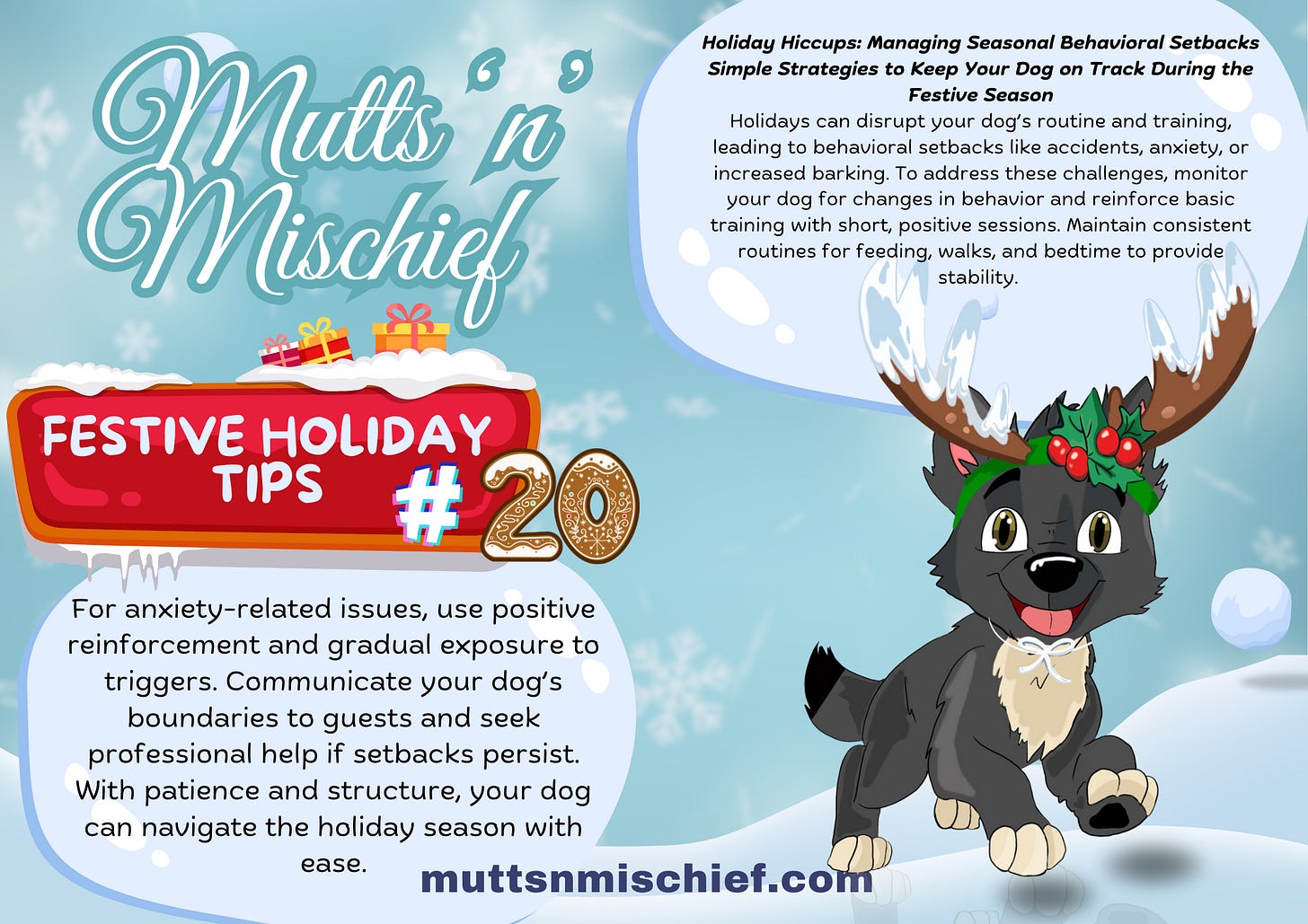🎄Mutts 'n' Mischief Festive holiday tip #20🎄
Holiday hiccups: Managing Seasonal Behavioural Setbacks - Simple Strategies to Keep Your Dog on Track During the Festive Season
🐾 Holidays can often disrupt your dog’s training, routines, and behavior, especially if they are exposed to too many stressors. Whether it’s a temporary lapse in their manners due to overstimulation or a regression in their progress with certain behaviors, addressing any setbacks early can prevent long-term issues. Recognizing when your dog is struggling and taking proactive steps to restore their behavior is crucial for maintaining a strong, positive relationship with your dog.
🐕🦺 Key Considerations for Addressing Behavioral Setbacks
Identifying Behavioral Changes
Risk: Dogs that are exposed to overstimulation or stress during the holidays may display behavior changes, such as increased barking, accidents in the house, or avoidance behaviors.
Prevention Tips: Monitor your dog closely during and after the holiday season. Look for signs of behavioral regression, such as accidents inside the house, increased aggression, or a lack of interest in activities they normally enjoy.
If you notice any setbacks, be patient with your dog. Remember that behavior changes due to stress or anxiety can be temporary and can improve with consistent work.
Returning to Basic Training
Risk: Behavioral setbacks can sometimes be a result of a temporary loss of focus or consistency in training.
Prevention Tips: Go back to the basics by reinforcing your dog’s basic commands and manners. Even if they’re well-trained, a refresher can help regain control and re-establish boundaries.
Break down training into smaller, manageable steps. This makes it easier for your dog to re-learn what’s expected of them.
Keep training sessions short, fun, and positive to avoid overwhelming your dog during their recovery period.
Addressing Anxiety-Related Behaviors
Risk: Anxiety from the holiday chaos can lead to setbacks in behavior, especially for dogs that are already prone to fear or separation anxiety.
Prevention Tips: If anxiety is a concern, focus on positive reinforcement techniques to help your dog overcome fearful or anxious behaviors. Use treats and praise to reward calm behavior and gradually expose your dog to the stimuli that caused anxiety in a controlled way.
If your dog’s anxiety seems more severe or persistent, consider consulting a dog behaviorist or your veterinarian for additional support, such as behavioral therapy or medication.
Consistency is Key
Risk: Inconsistent routines or lack of supervision can contribute to setbacks in behavior.
Prevention Tips: Maintain a consistent routine for your dog, even during busy times. If possible, try to continue your dog’s regular feeding, walking, and bedtime schedules to help them feel secure.
Provide clear boundaries and structure during the holidays. Make sure guests and family members are aware of your dog’s training needs and follow the same rules regarding interactions with your dog.
Seek Professional Help if Needed
Risk: In some cases, behavioral issues may be too much for a dog guardian to address alone.
Prevention Tips: If you find that your dog’s behavioral setbacks persist beyond the holiday season or become more severe, it may be time to seek professional help from a dog trainer or behaviorist.
🐾 A professional can help assess your dog’s needs, offer personalized strategies for addressing setbacks, and provide additional support for any underlying behavioral issues.
Signs of Behavioral Setbacks
Unexplained accidents inside the house.
Increased barking, whining, or vocalizations.
Aggressive behaviors such as growling, snapping, or biting.
Withdrawal or avoidance of people, other pets, or activities.
Destructive behavior, such as chewing or digging.
If you notice any of these signs, address them early by reinforcing training, offering additional reassurance, and seeking professional help.
🐕🦺 Action Steps for Guardians
Monitor your dog for any signs of behavioral setbacks and take note of any unusual behavior.
Reinforce basic training and gradually reintroduce structure into your dog’s routine.
Address any anxiety-related behaviors with positive reinforcement techniques and consider professional support if necessary.
Be consistent with your dog’s routine and training to avoid further setbacks.





